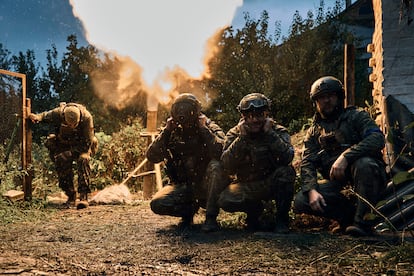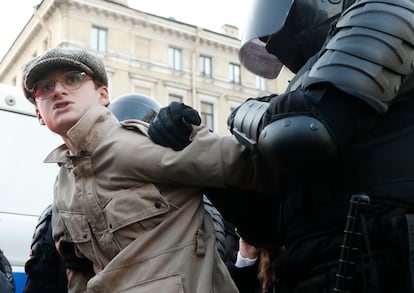How will Russia’s partial mobilization impact the war in Ukraine?
Experts say that while the measure presents many logistical challenges and is unlikely to change the course of the conflict, it may prolong the fighting

Last week, Russian President Vladimir Putin announced a partial military mobilization following recent setbacks in his war against Ukraine. Whether this measure will succeed or fail depends on many factors.
Politically, the partial mobilization has been met with mounting criticism, which could hurt support for the war in Ukraine and the regime that started it. The measure, which will see around 300,000 reservists called up to serve in Russia’s military campaign in Ukraine, has already sparked criticism from Putin’s allies, such as the head of the Chechen Republic Ramzan Kadyrov, who said that he would not recruit soldiers from his region and that authorities should send police officers, riot police and security personnel to the front instead.
On a logistical and military level, the Kremlin also faces huge challenges. Mobilizing hundreds of thousands of people with little or no military training not only requires conscription – which is highly unpopular – but also a massive effort to ensure they are housed, clothed, armed, trained and properly placed into Russia’s existing military structures. And many signs indicate that Russia is not prepared to carry out this operation effectively.
The Russian army doesn’t even have enough material to supply new recruits, according to a source from a Western intelligence agency. A few days ago, Putin ordered defense companies to speed up and increase production, but even uniforms are still missing.
“It’s one thing to mobilize some 300,000 people, it’s quite another to inject 300,000 trained soldiers into the front lines,” says Anthony King, professor of war studies at Britain’s University of Warwick. “The Russian forces are terrible when it comes to selection and training. It is, in general, an unprofessional, corrupt system, prone to bullying attitudes. They are not properly prepared to incorporate all of this effectively.”

Military analyst Dara Massicot, from Rand consultancy, agrees that the new force will not be up to the task. The Russian Ministry of Defense said the new recruits will receive a two-week training course before going to the front, which is completely “insufficient,” says the expert. During the Soviet Union, the armed forces maintained structures that were not functionally operational, but rather designed to help new recruits integrate in the event of mass mobilization. But this measure was abandoned long ago. What’s more, the task of integrating new soldiers will be done in a high-stakes, high-stress scenario.
Jack Watling, an expert at the Royal United Services Institute (RUSI) in the United Kingdom, points out specific problems in this regard. For example, Russian recruits usually complete their training in their units, which are now deployed in Ukraine. And the instructors who typically train recruits have also been sent to the front line.
“To take new recruits, turn them into units with a basic level of training, refurbish old equipment and distribute it, and create the command and control for any sort of offensive manoeuvres will take months,” noted Watling in an article published by RUSI. But with Ukraine intensifying its counterattack, Russia may be forced to move faster.
Intelligence sources indicate that most new recruits will be assigned to logistical positions, which will allow soldiers to move to the center of fighting, and also increase rotations. After 180 days on the front, soldiers become less effective, and many of them have been fighting for more than 200 days.
In systemic terms, the Kremlin must also decide how many recruits will go towards replenishing decimated units, and how many will be used to build new formations, says Watling. According to the expert, topping up existing units would “likely help to stabilize defensive lines, increasing the level of resources Kyiv must commit to achieve breakthroughs.” But, he adds, this is “unlikely to change the direction of fighting on the ground” as these forces lack artillery and arsenals, something which the new troops would not change.
But creating new units from the recruits also poses challenges, since they would “likely to be equipped with an assortment of older weaponry,” says Watling. Military history shows that infantry-heavy formations can be effective, for example, when China drove back US forces in Korea. But in this case, he explains, the People’s Liberation Army was made up of experienced and motivated veterans, a situation that does not apply to Russia’s new recruits.
What’s more, Russia’s partial mobilization runs the risk of exacerbating the problems seen in the army’s command and control structure, cooperation between units and multilevel offensives. If these issues were already evident with Russia’s professional troops and its unorthodox mix of mercenaries, prisoners and militias, they may worsen with a third wave of conscripts.
The second potential problem of the mobilization, aside from the backlash from Russian society, is that it may further demoralize Russia’s soldiers. The war in Ukraine has been greatly influenced by the difference in determination between Ukrainian and Russian forces. The arrival of Russian conscripts dragged against their will has every possibility of making the situation worse.
“Still, it shouldn’t be dismissed as a doomed operation,” says King. “I don’t think they can assemble a force of 300,000 trained troops, but they could eventually deploy a few tens of thousands. That will change the battlefield in some way.”
Many experts agree that while the partial mobilization is unlikely to change the course of the war, it may boost Russia’s forces and prolong the conflict, which under current conditions, could not have been sustained for much longer.
“It won’t solve many of Russia’s military’s challenges in this war, but it could alter the dynamic. Fair to say that these are uncharted waters, and so we should take care with deterministic or definitive claims,” Michael Kofman, a renowned expert on Russian military issues, wrote in a message on Twitter. “I wouldn’t suggest that this can turn around Russia’s fortunes in the war. However, I would take care being overly dismissive, especially looking out towards the medium term of this winter and 2023. Force availability and manpower matters.”
Tu suscripción se está usando en otro dispositivo
¿Quieres añadir otro usuario a tu suscripción?
Si continúas leyendo en este dispositivo, no se podrá leer en el otro.
FlechaTu suscripción se está usando en otro dispositivo y solo puedes acceder a EL PAÍS desde un dispositivo a la vez.
Si quieres compartir tu cuenta, cambia tu suscripción a la modalidad Premium, así podrás añadir otro usuario. Cada uno accederá con su propia cuenta de email, lo que os permitirá personalizar vuestra experiencia en EL PAÍS.
¿Tienes una suscripción de empresa? Accede aquí para contratar más cuentas.
En el caso de no saber quién está usando tu cuenta, te recomendamos cambiar tu contraseña aquí.
Si decides continuar compartiendo tu cuenta, este mensaje se mostrará en tu dispositivo y en el de la otra persona que está usando tu cuenta de forma indefinida, afectando a tu experiencia de lectura. Puedes consultar aquí los términos y condiciones de la suscripción digital.
More information
Últimas noticias
Most viewed
- Sinaloa Cartel war is taking its toll on Los Chapitos
- Oona Chaplin: ‘I told James Cameron that I was living in a treehouse and starting a permaculture project with a friend’
- Reinhard Genzel, Nobel laureate in physics: ‘One-minute videos will never give you the truth’
- Why the price of coffee has skyrocketed: from Brazilian plantations to specialty coffee houses
- Silver prices are going crazy: This is what’s fueling the rally










































